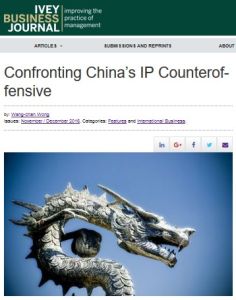
Wang-chan Wong
Confronting China’s IP Counteroffensive
Ivey Business Journal, 2016
What's inside?
Foreign companies take heed: China’s government is stepping up copyright protection.
Recommendation
China came late to the patent-law game, beginning in 1984, and even then it was a slow start. The Chinese government revamped its patent law in 2000 as it entered the World Trade Organization and tweaked it further in 2008. Between 2006 and 2013, domestic patent applications increased by nearly 900%. getAbstract recommends Wang-chan Wong’s perceptive and prescient look at the future of Chinese patents to stakeholders in foreign firms that wish to do business in China.
Take-Aways
- The number of Chinese patents in manufacturing and technology has grown exponentially.
- Patents filed or issued outside China offer little protection in China.
- Most Chinese companies seek the Utility Model (UM) patent, which is easy to obtain, has lax initial inspection standards and is difficult to invalidate.
- Foreign firms that wish to do business in China need to implement an aggressive patenting policy.
- Filing UM patents in China offers three benefits to foreign firms: It signals advanced technology, can lead to tax benefits and entices local business partners while discouraging local competition.
Summary
In the past, foreign companies’ main intellectual property (IP) risk in China was having their property pirated and copied. Now, they must take care not to breach Chinese copyright law. China has ambitions to become a “technological and innovative powerhouse.” To that end, the program for “China’s Medium and Long-term National Plan for Science and Technology Development 2006-2020,” for example, allocates incentives to innovative Chinese companies, including a $86.4 million fund for intellectual property protection (IPP) support as well as “tax advantages, subsidies and other privileges.”
“It is now time for foreign companies to expect to be sued because Chinese companies have learned from their IP battles and started building IP arsenals of their own.”
Chinese patent law offers three types of patents. Regular Invention Patents, similar to the US utility patent, protect real innovations; its examination process is thorough and can take three to five years. The Utility Model Patent (UM) covers incremental changes; the barriers to receiving the UM patent are low and the examination process is much faster. The Design Patent covers visual aspects of an object.
“Foreign players must…scan the competitive intelligence landscape to limit the risk of being sued by Chinese patent owners.”
While foreign companies tend to seek the Regular Invention Patents, Chinese companies go for UM patents. By the end of 2013, Chinese firms had filed 124 times more UM patent applications than their foreign counterparts. UM patents are cheap; they’re usually granted within a year; their effects extend for 10 years; and despite an insubstantial examination process, they are difficult to overturn. While these patents are primarily designed to protect small changes to existing products, they are flexible and easy to obtain. If a foreign firm protects a technology outside China but fails to get the Chinese UM patent, a Chinese company could patent the technology and then sue for infringement.
“Any Chinese entity can conceivably apply for a cheap, fast-track, under-examined UM patent on an existing product or process patented outside of China and then sue foreign manufacturers in China for infringement.”
To deal with this possibility, foreign companies must apply for patents before attempting to manufacture or sell their products in China. They also should get a good idea of the existing patents in their industry. Even firms that don’t have an immediate plan to enter China would benefit from filing UM patents early and often. Foreign entities that do apply for these patents before entering the Chinese market will find that UM patents lead to surprising benefits: They bestow tax breaks and signal success to competitors and would-be business partners. They also greatly reduce the chances of getting sued.
About the Author
Wang-chan Wong teaches at California State University, Dominguez Hills, in the College of Business Administration and Public Administration.
This document is restricted to personal use only.
My Highlights
Did you like this summary?
Read the articleThis summary has been shared with you by getAbstract.
We find, rate and summarize relevant knowledge to help people make better decisions in business and in their private lives.
Already a customer? Log in here.
















Comment on this summary